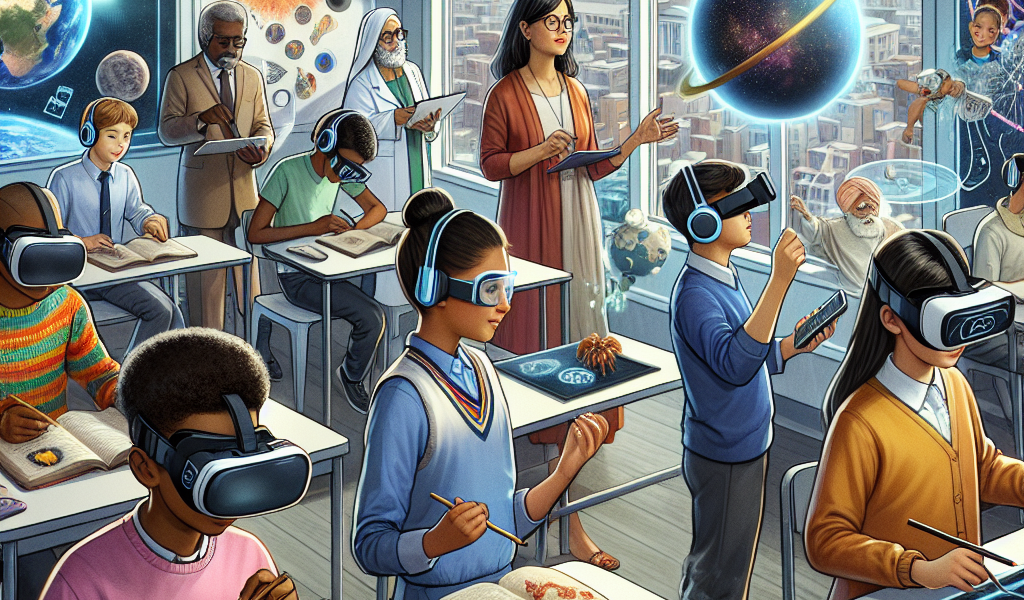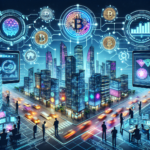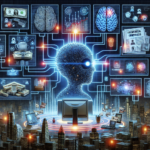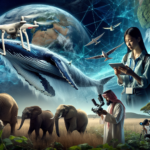-
Table of Contents
“Transforming Classrooms: The Immersive Future of AR and VR in Education”
Introduction
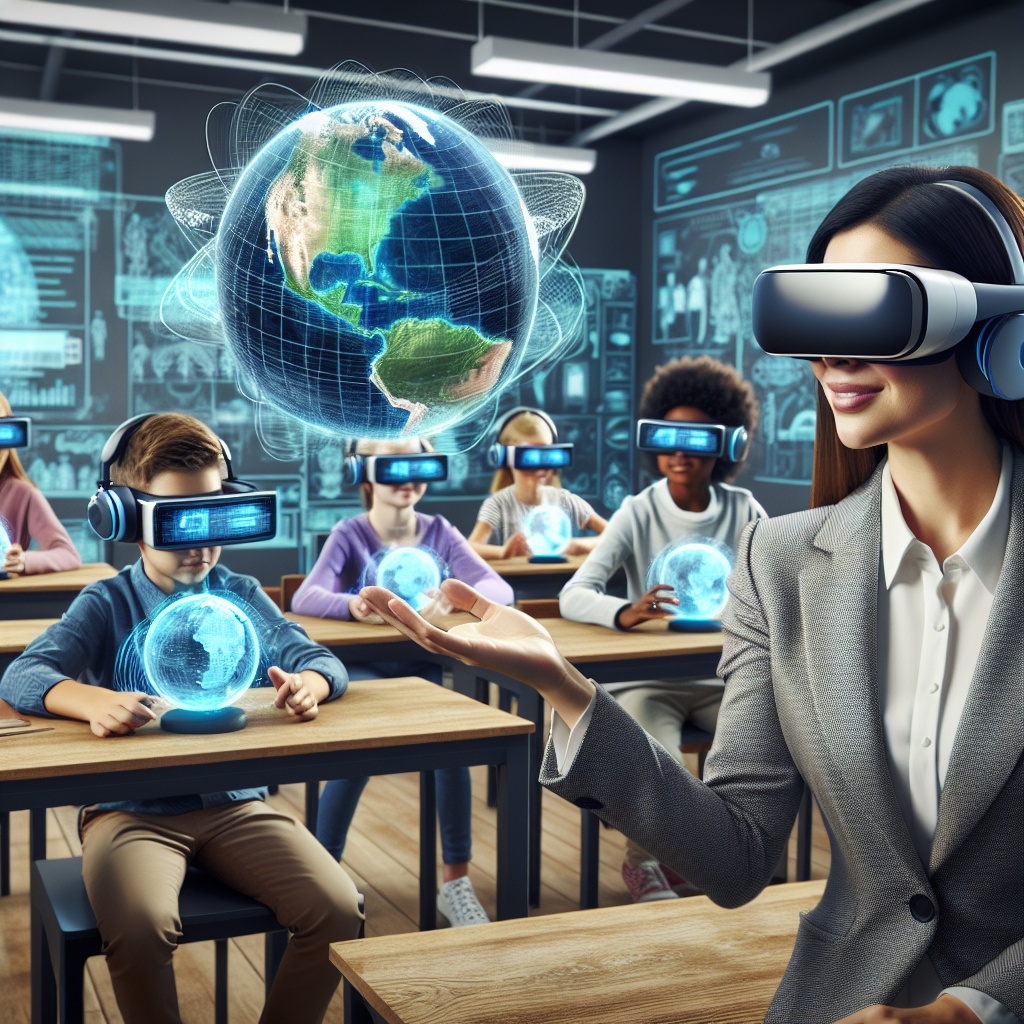
The future of Augmented Reality (AR) and Virtual Reality (VR) in education is poised to revolutionize the way students learn and interact with information. These immersive technologies offer unprecedented opportunities for creating engaging, interactive, and personalized learning experiences. AR and VR can transform traditional educational methods by providing virtual hands-on experiences, enhancing visual and spatial understanding, and enabling remote learning environments that are as effective as in-person instruction. As these technologies continue to advance, they promise to bridge gaps in education accessibility, cater to diverse learning styles, and prepare students for a technologically-driven world. The integration of AR and VR in education not only holds the potential to make learning more enjoyable and effective but also to foster a deeper understanding of complex subjects, ultimately shaping a more innovative and inclusive educational landscape.
Transforming Classrooms: The Role of AR and VR in Interactive Learning
The future of education is being reshaped by the rapid advancements in Augmented Reality (AR) and Virtual Reality (VR), technologies that are transforming classrooms into immersive learning environments. As educators and technologists explore the potential of these tools, it becomes increasingly clear that AR and VR are not just fleeting trends but pivotal elements in the evolution of interactive learning.
To begin with, AR and VR offer a level of engagement that traditional teaching methods often struggle to achieve. Imagine a history lesson where students can virtually walk through ancient Rome, or a biology class where they can explore the human body in 3D. These experiences are not only more engaging but also cater to various learning styles, making complex subjects more accessible and understandable. By providing a hands-on approach, AR and VR help students retain information more effectively, bridging the gap between theoretical knowledge and practical application.
Moreover, AR and VR can democratize education by providing access to resources that might otherwise be unavailable. For instance, students in remote or underfunded schools can take virtual field trips to museums, laboratories, or even outer space. This level of access can inspire a sense of curiosity and wonder, encouraging students to explore subjects they might not have considered before. Additionally, these technologies can be particularly beneficial for students with disabilities, offering customized learning experiences that accommodate their specific needs.
Transitioning to the role of teachers, AR and VR can serve as powerful tools to enhance instructional methods. Educators can use these technologies to create dynamic lesson plans that capture students’ attention and foster a more interactive classroom environment. For example, a geography teacher can use AR to overlay maps with real-time data, helping students understand the impact of climate change on different regions. This not only makes the lesson more engaging but also provides a deeper understanding of the subject matter.
Furthermore, AR and VR can facilitate collaborative learning, a crucial aspect of modern education. Students can work together on virtual projects, regardless of their physical location, fostering teamwork and communication skills. This is particularly relevant in today’s globalized world, where the ability to collaborate across borders is increasingly important. By simulating real-world scenarios, these technologies prepare students for the challenges they will face in their future careers.
However, the integration of AR and VR in education is not without its challenges. One of the primary concerns is the cost of implementing these technologies, which can be prohibitive for some schools. Additionally, there is a learning curve associated with using AR and VR tools, both for teachers and students. To address these issues, it is essential for educational institutions to invest in training and support, ensuring that educators are well-equipped to harness the full potential of these technologies.
Despite these challenges, the benefits of AR and VR in education are undeniable. As these technologies continue to evolve, they will become more accessible and user-friendly, paving the way for widespread adoption. The key to successful integration lies in a balanced approach, combining traditional teaching methods with innovative technologies to create a holistic learning experience.
In conclusion, AR and VR are set to revolutionize the educational landscape, offering unprecedented opportunities for interactive and immersive learning. By embracing these technologies, educators can transform classrooms into dynamic environments that inspire curiosity, foster collaboration, and enhance understanding. As we look to the future, it is clear that AR and VR will play a crucial role in shaping the next generation of learners, preparing them for the complexities of an ever-changing world.
Virtual Field Trips: Expanding Horizons Beyond the Classroom
Imagine a classroom where students can explore the pyramids of Egypt, dive into the depths of the Great Barrier Reef, or even walk on the surface of Mars—all without leaving their seats. This is not a scene from a science fiction movie but a glimpse into the future of education, made possible by the advancements in Augmented Reality (AR) and Virtual Reality (VR). These technologies are revolutionizing the way we think about learning, offering virtual field trips that expand horizons far beyond the traditional classroom.
The concept of virtual field trips is not entirely new, but the integration of AR and VR has taken it to unprecedented levels. Unlike traditional field trips, which are often limited by geographical, financial, and logistical constraints, virtual field trips offer limitless possibilities. With a VR headset, students can be instantly transported to any location in the world—or even beyond it. This immersive experience not only makes learning more engaging but also more accessible to students who might otherwise never have the opportunity to travel.
One of the most significant advantages of virtual field trips is their ability to provide a multisensory learning experience. While textbooks and videos can offer information, they often fail to engage students fully. In contrast, AR and VR can create an environment where students can see, hear, and even interact with their surroundings. For instance, a virtual trip to a historical site can include not just a visual tour but also audio narrations, interactive timelines, and even the ability to “meet” historical figures. This level of engagement can make learning more memorable and impactful.
Moreover, virtual field trips can be tailored to fit the curriculum and learning objectives of any subject. Science classes can benefit from virtual lab experiments, while geography lessons can include virtual tours of different ecosystems. Even literature classes can take students to the settings of the novels they are reading, providing a deeper understanding of the context and culture. This flexibility makes AR and VR an invaluable tool for educators looking to enrich their teaching methods.
However, the implementation of AR and VR in education is not without its challenges. The cost of VR headsets and AR-enabled devices can be prohibitive for some schools, particularly those in underfunded districts. Additionally, there is a learning curve associated with using these technologies effectively. Teachers need to be trained not only in the technical aspects but also in how to integrate these tools into their lesson plans meaningfully. Despite these hurdles, the potential benefits far outweigh the drawbacks, and many educational institutions are already making strides in this direction.
Furthermore, the COVID-19 pandemic has accelerated the adoption of digital tools in education, highlighting the need for innovative solutions like virtual field trips. With many schools shifting to remote learning, AR and VR offer a way to keep students engaged and connected to their studies. As technology continues to advance, we can expect these virtual experiences to become even more immersive and accessible.
In conclusion, the future of AR and VR in education is incredibly promising, particularly when it comes to virtual field trips. These technologies have the power to break down barriers, making learning more engaging, accessible, and comprehensive. While there are challenges to overcome, the potential to transform education is immense. As we look ahead, it is exciting to imagine a world where the boundaries of the classroom are no longer defined by walls but by the limitless possibilities of virtual exploration.
Personalized Learning: How AR and VR Tailor Education to Individual Needs
The future of education is being reshaped by the advent of augmented reality (AR) and virtual reality (VR), technologies that are revolutionizing the way students learn by tailoring education to individual needs. As these immersive technologies become more accessible, they offer unprecedented opportunities for personalized learning, making education more engaging, interactive, and effective.
One of the most significant advantages of AR and VR in education is their ability to create customized learning experiences. Unlike traditional classroom settings, where a one-size-fits-all approach often prevails, AR and VR can adapt to the unique learning styles and paces of individual students. For instance, a student struggling with complex mathematical concepts can use VR to visualize and interact with 3D models, making abstract ideas more concrete and easier to understand. Conversely, a student excelling in a particular subject can explore advanced topics through AR applications, ensuring they remain challenged and engaged.
Moreover, AR and VR facilitate experiential learning, which is crucial for deep understanding and retention of information. By immersing students in virtual environments, these technologies allow them to experience historical events, scientific phenomena, or even distant cultures firsthand. This not only makes learning more enjoyable but also helps students develop a more profound and personal connection to the material. For example, history lessons can be transformed into virtual time-travel experiences, where students can witness historical events as if they were actually there, fostering a deeper appreciation and understanding of the past.
In addition to enhancing engagement, AR and VR also provide valuable tools for assessment and feedback. Traditional testing methods often fail to capture the full spectrum of a student’s abilities and understanding. However, with AR and VR, educators can design interactive assessments that evaluate not just rote memorization but also critical thinking, problem-solving, and creativity. These technologies can track a student’s progress in real-time, offering immediate feedback and allowing for timely interventions when necessary. This continuous assessment helps educators identify areas where students may need additional support, ensuring that no one falls behind.
Furthermore, AR and VR can bridge the gap between theoretical knowledge and practical application. In fields such as medicine, engineering, and the sciences, hands-on experience is invaluable. VR simulations can provide students with realistic practice scenarios, from performing virtual surgeries to conducting complex experiments in a risk-free environment. This not only enhances their skills but also builds confidence, better preparing them for real-world challenges.
Another critical aspect of personalized learning through AR and VR is inclusivity. These technologies can be particularly beneficial for students with special needs, offering tailored experiences that accommodate various disabilities. For example, VR can create a controlled environment for students with autism, helping them develop social skills and navigate real-world situations at their own pace. Similarly, AR can provide visual and auditory aids for students with sensory impairments, making learning more accessible and inclusive.
As AR and VR continue to evolve, their potential to transform education becomes increasingly apparent. By offering personalized, immersive, and interactive learning experiences, these technologies are not only making education more effective but also more enjoyable. As schools and educators embrace these innovations, the future of education looks promising, with AR and VR paving the way for a more tailored and inclusive learning environment for all students.
Conclusion
The future of AR and VR in education is promising, with these technologies poised to revolutionize learning experiences. They offer immersive, interactive environments that enhance engagement, understanding, and retention of information. As AR and VR become more accessible and affordable, their integration into educational curricula is expected to grow, providing personalized learning experiences and bridging gaps in traditional education methods. This evolution will likely lead to more effective and inclusive education systems, preparing students for a technologically advanced world.

